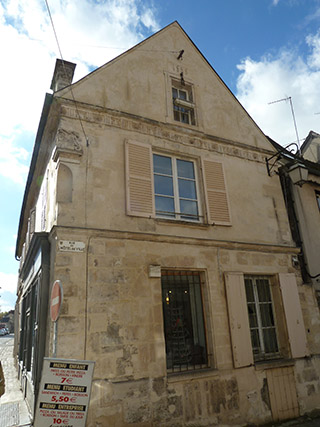Points d'intérêts de la rue d'hôtel de ville : Maison Henri II- Ancien auditoire royal…
Prochain point : lat="49.1559" lon="1.78589"

Rue de l’Hôtel de Ville
Evolving architectural styles
An old street with elaborate architecture
In the Middle Ages Magny-en-Vexin was a village with a very rural appearance, and was organised around a long main road. Only a few examples of this medieval architecture still exist. In the sixteenth century, when the town was arranged around two main axes (Paris-Rouen and Chartres-Beauvais), the houses took on a more urban character. They were larger and taller; the materials used to build them were more sophisticated; and the facades reflected the owner's reputation or profession. The Rue de l’Hôtel de Ville is one of the oldest streets in Magny-en-Vexin; formerly known as Rue d’En-Bas, it only assumed its current name in 1840.
The ‘house of Henry II’
This corner house is one of the most remarkable in Magny-en-Vexin. Its style is characteristic of the sixteenth century, with two storeys in cut stone and rough stone rendering, the sharply angled roof and regular apertures. The date ‘1555’ is engraved at the top of the gable. The house’s carved decoration also deserves attention: rosettes and bucrania (emaciated ox skulls), separated by triglyphs, feature on the frieze at the cornice. This includes the initial ‘H’ framed by volutes and bay leaves above a recessed corner niche. The niche overhung a carved door until 1855, and the monogram resulted in the dwelling being known as ‘Henry II’s house.’ It is more likely that the property was occupied by one of Henry’s finance officers, as implied by the decoration on the coins on the corner door that is no longer in situ. The building is attributed to the master mason Jean Grappin de Gisors, who worked on the church of Magny-en-Vexin at the same time.
Heraldic shield of France
A half-timbered house at number nine Rue de l’Hôtel de Ville, built in the early sixteenth century, is one of the town’s earliest buildings. Its style reflects the medieval heritage, as illustrated by the corbelled construction supported by wooden corbels (the upper floor overhangs the street) and the timber-framed structure filled with plaster (studs). The apertures were modified during a recent restoration. The decor is subtle, including the rose sculptures on the upper floor and the shield bearing the coat of arms ‘with twin fleurs de lys and an ermine surmounted by a crown.’ These arms are a tribute to Anne de Bretagne, wife of two kings of France: Charles VIII and Louis XII.
Marquis de Guiry Hotel
Built between 1617 and 1618, the property at number 17 Rue de l’Hôtel de Ville is a perfect example of the city’s beautification in the seventeenth century and the style of Louis XIII. The tall, narrow facade is made of dressed stone on the ground floor, whereas brick dominates on the upper floors. Bossage is used only for the quoins, the frames of the windows and doors, and the decoration. A turret (on the courtyard side) rounds off the ensemble.
The Royal Auditorium
This sixteenth-century building in partially coated dressed stone is located at 19-27 of Rue de l’Hôtel de Ville. It housed the old bailiwick’s mansion and royal auditorium, where the court and meetings for residents and municipal officers were held until the Revolution. The prison was situated in the basement. The municipality obtained the building to accommodate the town hall until 1840 before it was transferred to the former Ursuline convent.
The facade has been partially modified by the division into homes and the creation of new apertures on the ground floor. The ornamental items include the band separating the different levels and the niche containing a statue of Notre-Dame-de-Bon-Secours. The dormers, which light a mansard attic, are original.





